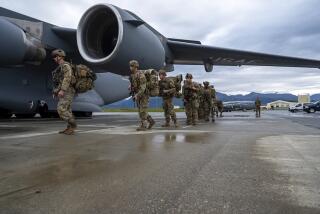Pentagon plans to add missile interceptors in Alaska
- Share via
WASHINGTON — The Pentagon plans to add 14 missile interceptors to a problem-plagued anti-missile system in Alaska aimed at North Korea, which has issued increasingly bellicose threats since it tested an underground nuclear device and launched a small satellite.
The upgraded ground-based interceptors would augment 26 interceptors already deployed at Ft. Greely, part of a multi-layered missile defense system that includes up to five Navy Aegis cruisers with tracking radars and their own interceptors in the northern Pacific. Four other anti-missile batteries are at Vandenberg Air Force Base at Lompoc.
The upgraded interceptors failed a test in December against a target resembling an incoming missile. Officials said Friday the new interceptors will be deployed only if a second test this fall is successful. Even then, they won’t be installed until the end of 2017.
“We certainly will not go forward with the additional 14 interceptors until we are sure that we have the complete confidence we need,” Defense Secretary Chuck Hagel, who announced the deployment, said at a Pentagon news conference. “But the American people should be assured that our interceptors are effective.”
The plan to boost America’s defense posture comes three days after James R. Clapper, America’s top intelligence officer, warned in a congressional hearing for the first time that North Korea’s nuclear weapons and missile programs “pose a serious threat to the United States” as well as its East Asian neighbors.
The anti-missile deployment is aimed, in part, at warning Pyongyang that America is not reducing its defenses despite cuts to the Pentagon budget. Analysts described the move as a modest step to reassure allies without adding considerably to America’s defenses. But Pentagon officials said they are also seeking to stay ahead of North Korea’s missiles and nuclear programs, which they said had progressed more swiftly than anticipated.
“The Korean threat went just a little bit faster than we might have expected,” Adm. James Winnefeld, vice chairman of the Joint Chiefs of Staff, told reporters. He said the Pentagon “very simply pulled the tools off the shelf.”
U.S. officials believe North Korea is years away from developing long-range ballistic missiles capable of striking the continental United States. The Taepodong 2 missile theoretically has the range to hit parts of Alaska, but it has been plagued with flight problems.
Winnefeld said a new larger North Korean ballistic missile, called the KN-08, “probably does have the range to hit the United States” but he declined to say if U.S. intelligence believed it was operational.
Six KN-08s were displayed in a parade in Pyongyang last April, but U.S. intelligence agencies believe they may have been fakes.
U.S. officials also say there is no evidence North Korea has produced a nuclear warhead small enough for ballistic missiles, despite Pyongyang’s claims to have done so.
The decision to boost the number of interceptors to 44 marked a reversal for the Obama administration, which canceled additional deployments in 2009 shortly after it took office. The George W. Bush administration had proposed installing 44 interceptors.
Pentagon officials stressed that the anti-missile system was aimed at North Korea, not China, which has long had concerns that the U.S. system would degrade the deterrent effect of its small nuclear arsenal. The officials said Beijing was informed of the deployment before the public announcement.
North Korea has stepped up its rhetoric in recent weeks, including a threat to make Seoul a “sea of fire” and to carry out preemptive nuclear attacks on Washington. It has demanded that the Pentagon and South Korea cease joint military exercises that are now underway, claiming they are masking a planned invasion.
The confrontational stand dampened hopes that North Korea might follow a more moderate course under its 30-year-old leader, Kim Jong Un, who assumed command 13 months ago after the death of his father, Kim Jong Il.
In the news conference Friday, Winnefeld used unusually direct language to refer to the new leader’s relative youth and experience.
“We believe this young lad ought to be deterred by [the U.S. anti-missile system], and if he’s not, we’ll be ready,” Winnefeld said.
Some analysts argued that the new interceptors had limited military benefit. The Arms Control Assn., a Washington policy analysis group, said they “add a very modest, mostly symbolic response to North Korean nuclear and missile saber-rattling.”
But Sen. James M. Inhofe (R-Okla.), ranking member of the Senate Armed Services Committee, said the deployment added “a much-needed measure of protection against the North Korean threat.”
Hagel said the Pentagon would proceed with a plan announced last year to deploy a second missile defense radar in Japan, and would begin environmental impact studies for three alternative sites for ground-based interceptors, if needed, including two on the East Coast.
The U.S. is also putting in place a missile defense system in Europe aimed at Iran, which is also developing longer-range ballistic missiles that could eventually be capable of threatening Europe and even, in theory, the United States, though that is considered many years away.
Hagel said the U.S. was speeding up deployment of advanced interceptors in Europe, including at sites in Poland and Romania, to ensure that all European members of NATO would be covered by the system by 2018.
More to Read
Sign up for Essential California
The most important California stories and recommendations in your inbox every morning.
You may occasionally receive promotional content from the Los Angeles Times.











